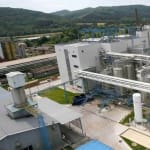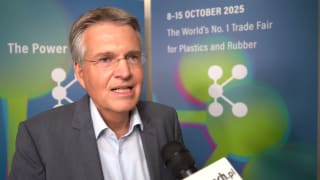 Vehicle tires of course belong on the road, but for the last two decades, they have also increasingly found their way into the road. That is made possible by recycled scrap tires and Vestenamer, a process aid manufactured by Evonik Industries for the rubber and construction sector.
Vehicle tires of course belong on the road, but for the last two decades, they have also increasingly found their way into the road. That is made possible by recycled scrap tires and Vestenamer, a process aid manufactured by Evonik Industries for the rubber and construction sector.The European highway network nowadays comprises nearly 75,000 km and is steadily expanding further. Parallel to new construction, roads and bridges must be maintained in order to keep the Old Continent’s traffic, and the associated economic growth, flowing.
As an additional complexity, vehicle ownership per 1,000 residents has more than doubled within the European Union since 1975 and long-distance goods transport by truck has grown considerably. While truck shipments accounted for approx. 1,000 billion metric ton-kilometers in 1990, they rose to about 1,750 billion metric ton-kilometers in 2015 according to statistics of the EU Commission. These developments represent a major challenge for Europe's infrastructure.
Innovation for road construction
Road quality and durability are key concerns for the public sector. The clearly emerging demand for high-performance road construction materials to avoid ruts and cracks - and to save maintenance costs - is increasingly moving into public awareness. At the same time, raw material costs for asphalt, and specifically for asphalt modification compounds, have increased considerably, creating another obstacle to cost-effective road construction. Obviously, there is a need for alternative concepts.Evonik is pursuing a sustainable and cost-effective approach to road construction. Vestenamer, the specialty chemical company's process additive for the rubber industry, makes it feasible to process rubber powder from scrap tires to generate asphalt with rubber content. The recycled material is mixed into road construction bitumen or asphalt to improve the quality of the mixtures and to extend the service life of road surfaces.
Extended service life, less noise
In the United States, asphalt mixtures containing rubber have been used for decades. Long-term studies have demonstrated a significant improvement in road durability. "The market for elastomer-modified, i.e. rubber-containing, road surfaces has been growing in Europe over the past years as well," says Frank Lindner, senior business manager for Vestenamer. "The positive properties are obvious since the material significantly reduces cracking, ruts and potholes in the road surface, which in turn extends road service life."Another sensory experience also speaks in favor of using rubber-modified bitumen: The rubber powder is frequently used in porous asphalt - also known as low-noise asphalt - that cuts down on traffic noise. Scientific studies have documented that using larger shares of rubber powder in road surfaces can result in a noise reduction of one to two decibels. This is highly significant because in human perception, a reduction by 3 dB is comparable to cutting the traffic volume in half.
Making sensible and efficient use of scrap tires
Every year, a waste volume of some 19.3 million metric tons of scrap tires is generated worldwide - including over 3.6 million metric tons in Europe alone. 20 years ago, over half of all scrap tires were incinerated to generate energy in Germany alone, while only every tenth scrap tire was processed into granulate. By now, the volume of the latter has caught up with energy-related processing.Recycling scrap tires definitely makes environmental sense. "Reusing recycled tires secures valuable resources," says Thomas Engenhorst, sustainability strategy manager in the Resource Efficiency Segment of Evonik. "Tires are not classified as waste, but are considered a valuable material, which may not, for example, be disposed of in landfills. This use eliminates the disposal question: Instead of incinerating the tires, they have another life stage in road traffic - not as part of an engine-powered vehicle, but in the form of an elastomer or rubber powder in the road surface."
As part of a test track in the German town of Paderborn, the local road Detmolder Strasse was resurfaced in 2012 in compliance with the objectives of the EU Waste Directive. 50% of the new asphalt mixture consisted of milled material - asphalt granulate - from the old road. The new mixture formulation also included rubber powder and Vestenamer. For every 100 m of track, some 80 scrap tires were turned into an elastomer-modified road surface, along with recycling the old asphalt.


